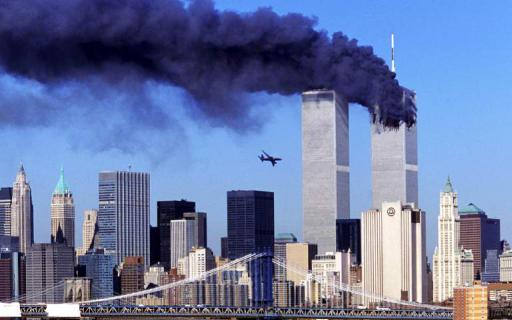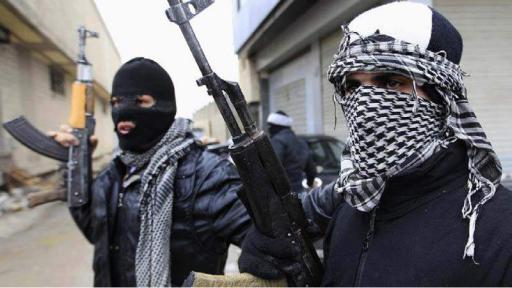
512
.pdfФЕДЕРАЛЬНОЕ ГОСУДАРСТВЕННОЕ КАЗЕННОЕ ОБРАЗОВАТЕЛЬНОЕ УЧРЕЖДЕНИЕ ВЫСШЕГО ОБРАЗОВАНИЯ
МОСКОВСКИЙ УНИВЕРСИТЕТ МВД РОССИИ ИМЕНИ В.Я.КИКОТЯ
КАФЕДРА ИНОСТРАННЫХ ЯЗЫКОВ
И.А.ГОРШЕНЕВА В.Н. КУЛИКОВ
GLOBAL THREATS OF TERRORISM
УЧЕБНО-МЕТОДИЧЕСКОЕ ПОСОБИЕ
Москва 2019
Пояснительная записка
ДанноеучебноепособиесоставленоЗаслуженнымработникомВысшей школы РФ, к.ю.н., профессором И.А.Горшеневой и старшим преподавателем кафедры иностранных языков В.Н.Куликовым.
Настоящее учебное пособие “Global Threats of Terrorism” является комплексным и коммуникативно-ориентированным, что способствует развитию у обучающихся умений и навыков во всех видах речевой деятельности.
Цель пособия – поэтапное формирование иноязычной коммуникативной компетенции как инструмента осуществления межкультурного взаимодействия и взаимопонимания в ходе профессионального и делового общения.
Пособие состоит из 3 Units, организованных по темам, раскрывающим различные аспекты и проблемы мирового терроризма. В пособие включен аутентичный текстовый материал, который служит содержательной основой для чтения, осмысления и обсуждения. Все тексты отражают актуальные проблемы современного общества в рамках предложенной тематики. Разделы (Units) снабжены комплексом предтекстовых и послетекстовых упражнений, ориентированных на развитие навыков аналитической работы с общественнополитическими текстами и их критического осмысления, дискурс-анализа, расширение словарного запаса обучающихся, совершенствование умений ведения дискуссии, поиска информации в сети Интернет, а также на формирование навыков подготовки устных презентаций.
Пособие призвано совершенствовать технологии скоростных видов чтения(просмотровогоивыборочного),навыковаудированияновостныхСМИ и, в целом, развития дискурсивной компетенции.
Пособие может быть использовано как на аудиторных занятиях, так и в ходе самостоятельной работы.

UNIT I.
WHAT IS TERRORISM?
Warm-up Activities
1.Look at the pictures. How can you comment on them?
2.Think of as many words as possible related to the accidents shown in the pictures.
3.What is terrorism? Give your own definition.

Pre-text activity
1.What do you think of when you hear the word 'terrorism'?
2.What associations do you have?
3.Why do people resort to terrorism?
4.Who can become a terrorist?
5.What are the chief characteristics of terrorism?
READING TASK: You are going to read an article about terrorism. Scan the text and be ready to explain the origin of this notion and its main features.
Terrorism is the use or threat of violence that is limited in its physical destructiveness but high in psychological impact because it creates fear and shock. Terrorism's effectiveness is political rather than military. The terrorist act is meant to communicate a message to a watching audience. Assassinations of prominent figures in society or attacks on civilians chosen at random from a targeted group are typical of terrorism. Bombings are the most common form.
Conventionally the term applies to the acts of revolutionaries or nationalists
who challenge governments, while "terror" refers to government actions to crush resistance. In practice, the distinction between terrorism and terror is not always clear. Extremists of the right as well as the left and governments as well as underground organizations use terrorism. Often part of extended conflicts, it can also be the exclusive resort of groups too weak or secretive to mount an open assault. Terrorism alone, however, is unlikely to topple any government.
The term originated as a description of the Reign of Terror (1793-1794) during the French revolution. In the late 19th century terrorism was turned against the state, for example, in the actions of Russian revolutionaries, European anarchists, and Irish nationalists. After world War I terrorism in Europe merited discussion in the League of Nations. Terrorism also figured in the Indian independence movement, although Gandhi discouraged its use.
In the 1950s and 1960s terrorism was associated with insurgencies in European colonies. Yet as independence movements succeeded, terrorism escalated. Seizing hostages in order to make demands on governments also became characteristic of terrorism. Kidnappings of diplomats, business executives, and other symbols of foreign influence were earned out by Latin American revolutionary groups. Hijacking of civilian aircraft was linked to the Arab-Israeli conflict and Palestinian nationalism.
In the 1970s terrorism became a domestic problem for Italy, Spain, Great Britain, and Northern Ireland. The Iranian revolution reinforced the anti-American and anti-Western dimension of terrorism, as was demonstrated by the seizure of American diplomats in 1979, followed by the bombing of the U.S. Marine barracks (1983) and kidnappings of foreigners by pro-Iranian groups in Lebanon. Peru and India, too, were troubled by terrorism in the 1980s and 1990s, midair bombings of international airline flights, notably of a U.S. commercial flight over Lockerbie, Scotland, in 1988, heightened public concern.
After 1968 numerous treaties and conventions under the auspices of the United Nations and other international organizations were aimed at preventing terrorism, especially attacks on civil aviation and on diplomats. Cooperation among nations developed slowly. Some states took unilateral action, such as retaliation or military intervention to rescue hostages. In 1968 the United States conducted a retaliatory bombing raid against Libya, a nation accused of sponsoring terrorism. Israeli policy, too, calls for military retaliation against terrorism. Throughout history, terrorism has claimed millions of innocent lives and disrupted societies all over the world.
But what exactly is terrorism? Despite controversy over which incidents can truly be called acts of terrorism, the term can be defined as the use or threat of violence to achieve a specific goal. Terrorism generally can be divided into two categories: state terrorism, or terrorism from above, in which governments lash out against their own people, and terrorism from below, in which groups or individuals try to disrupt the civil order to further their own agendas. Governments resort to terror to prevent other parties or popular movements from taking control, while groups or individuals use terrorism for various reasons, such as to fight against unpopular governments, to send a political message, or to further a criminal enterprise.
Support and protection of one's religion has also been a strong motivation for terrorism throughout history. While state terrorists have used the full force of a government's police and military against their enemies, individuals and groups have resorted to strategies such as kidnappings, hijackings and bombings. Terrorists have used these guerrilla-style tactics with the intention of striking fear into thousands of people, while hoping that the media will bring their message to the world's attention. Individual terrorists come from a wide range of social, political and cultural backgrounds. Many are young, passionate and revengeful, and most
importantly, are willing to die for their cause. Fuelled by their hatred and fanaticism, terrorism has become a horrifyingly common occurrence in today's world.
Exercise 1. Pronounce the words correctly. If it is necessary, consult the dictionary:
insurgency, guerrilla-style, to heighten public concern, under the auspices of, retaliation, open assault, Lebanon, India, Peru, pro-Iranian, revengeful, to seize hostages, occurrence.
Exercise 2. Look at the words/phrases in bold in the text and try to explain them:
threat of violence, assassination, attacks on civilians, at random, to challenge governments, to crush resistance, to topple governments, kidnapping, hijacking, to be aimed at, to rescue hostages, to lash out, fuelled, fanaticism, midair bombings
Exercise 3. Match the words in column A to the relevant phrases in column B.
A |
B |
|
|
1. hijacking |
a. an attempt to take control a country by force |
|
|
2. bombing |
b. a person, not part of a regular military force, |
|
who engages in warfare |
|
|
3. kidnapping |
c. to murder an important person, especially for |
|
political reasons |
|
|
4. insurgency |
d. to take control of a vehicle (a plane) in order to |
|
demand smth. from government |
|
|
5. assassination |
e. the act of attacking a building or an area in |
|
|
|
order to take control of it |
|
|
6. assault |
f. an occasion when a bomb is dropped or left |
|
somewhere |
|
|
7. guerilla |
g. to take a person away illegally and keep him |
|
(her) as a prisoner |
|
|
Exercise 4. Fill in the correct word derived from the words in brackets.
Terrorism works by acting directly on the public through 1)……………..(intimidate).Terrorists use different methods to terrorize people such as kidnapping, setting off bombs, hijacking and 2)…………….(assassinate). Most terrorist groups have a small number
of members. Unlike ordinary 3)……………….(crime), their goals are not to acquire money or some other form of personal gain. Terrorists attack people who oppose their cause or objects that symbolize such 4)……………..(oppose). Terrorist acts are committed for a 5)……………….(various) of reasons. Some terrorist groups support a particular political philosophy. Other organizations represent ethnic groups seeking 6)…………………(liberate) from 7)……………………(govern) in power. Terrorist dictators employ 8)……………………….(violate) to frighten or eliminate their 9)……………………..(oppose). Terrorists believe the threat or use of violence is the best way to create fear, gain publicity and 10)………………………….(notorious), and increase support for their causes.
Exercise 5. Translate the following sentences from Russian into English:
1. В Испании арестованы несколько человек, оказывавших поддержку террористам.
2. Американские спецслужбы получили сведения, что террорист-смертник
готовится к теракту против США на Ближнем Востоке.
3. Сейчас в мире насчитывается около 500 групп и организаций, использующих в своей деятельности террор, на всех континентах, за исключением Австралии и Антарктиды. В настоящее время в террористических актах ежегодно гибнет свыше 5 тысяч человек.
4. 90% терактов составляют взрывы бомб, обстрелы и вооруженные нападения. 5. Международные радикальные террористические организации широко используют неправительственные организации как для сбора средств, так и для обеспечения своей деятельности.
6.Правительство США принимает меры по замораживанию банковских счетов террористов, пресечению сбора средств и вербовки террористов.
7.Полиция получила право закрывать выезд из городов в случае терактов с применением химического или биологического оружия.
8.Министр здравоохранения заявил: «Следует принять все меры предосторожности на случай распространения смертельно опасных инфекций».
9.Профессор Майкл Лэнгман сказал, что если террористы применят химическое или биологическое оружие начнётся паника.
Exercise 6. Give proper words to the following definitions:
1.a strong or powerful influence or effect caused or produced by an idea, invention, event etc.
2.a murder (of a ruler, politician, or other important person)
3.of great importance, fame, etc.
4.a person, not of the armed forces
5.to make or become more serious by stages
6.something bad done to someone who has done something bad to you
7.to demand
Follow-up Activities
1.In pairs ask and answer questions based on the text of Unit I.
2.Read the text of Unit I again and answer the following questions or do the task:
a)looking into the text
b)without looking into the text
1.What is the difference between the words "terror" and "terrorism"?
2.What are the origins of the term?
3.Tell about different periods in the record of terrorism.
4.How can you define a mastermind of terrorism?
5.What can help people be immune to terrorism?
6.What does the term “global terrorism” imply for?
7.Can you recall any explosions of terrorism?
8.Can you recall any examples of acts of terrorism?
9.What do you think can be done to eliminate terrorism?
Read the newspaper article and discuss it with your partner.
Domodedovo airport hit by deadly bombing
Suspected suicide attack kills at least 35 at Moscow's main airport, after security agencies reportedly received a warning
-Luke Harding and Tom Parfitt in Moscow, Guardian.co.uk, Monday 24 January 2011
At least 35 people were killed and 130 injured in a suspected suicide bombing
